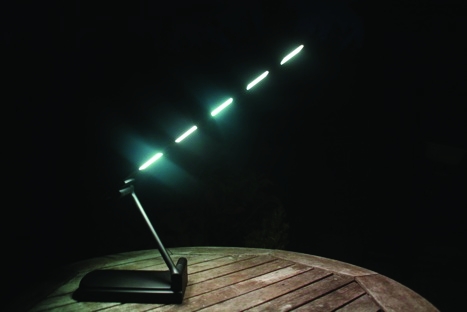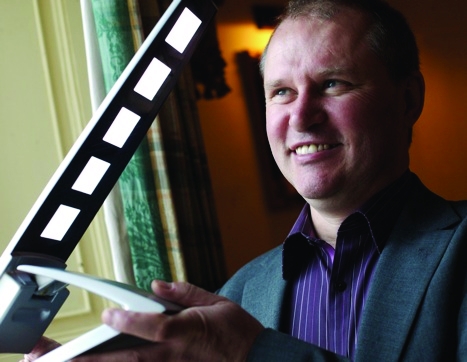The rapid advance of LED technology over the last few years – and its energy saving possibilities – gives it the clear potential to become the dominant form of lighting in the near future. But it’s not so obvious what form of light-emitting diode will be most widely used, and keeping up with the competitors’ progress can be as difficult as remembering all their acronyms.
For global supplier Thorn Lighting and spin-out firm Cambridge Display Technology (CDT), the possibilities offered by organic polymer LEDs (PLEDs) and the high-volume printing process used to manufacture them were an exciting prospect.

The problem was that white PLEDs in the laboratory were several orders of magnitude worse than their regular organic LED (OLED) counterparts in terms of efficiency and lifespan. Hence the creation, in partnership with Durham University, of Project TOPLESS – an investigation of Thin Organic Polymeric Light Emitting Semiconductor Surfaces given a more attention-grabbing name.
Funded by a 50 per cent investment from the Technology Strategy Board, the £3.3m project aimed to take PLED technology from the laboratory and improve its performance ready to be commercialised. ‘CDT are the world leaders in light-emitting polymers so we weren’t starting from scratch– they had 20 years of high-level research knowledge to bring to the project,’ says project leader and Thorn Lighting’s OLED group leader Dr Geoff Williams.
‘But we took the materials from being a research-oriented and driven technology to being an industrial and customer-oriented technology. We had to address performance in terms of efficiency, lifespan, colour, brightness and stability: the parameters that made in suitable for lighting applications in an office environment.’
All organic LEDs have the advantage of being incredibly thin and lightweight, often just 100 nanometres thick. They consist of a semiconductor film of organic compounds that emits light when an electric current is passed through it, sandwiched between transparent electrodes.
Where PLEDs have an advantage is in their production process. Using long-chains rather than small organic molecules means the semiconductor film can be printed from solution onto a substrate at atmospheric pressure, instead of thermally evaporated in a vacuum.
‘We’re going for a painting or printing process rather than a high-energy consuming technology,’ explains Williams. ‘What that means from a manufacturing perspective is our PLED lighting is three, possibly four layers thick for optimised use against OLEDs, where devices in the laboratory are 17 layers thick but lower numbers, probably 10 to 12 layers, in a manufacturing environment.’
But this advantage isn’t about how much organic compound is being used – it’s not ‘bucket chemistry’, as Williams puts it. ‘One kilogram of light-emitting polymer coats two football pitches so it goes an awful long way. I believe the solution processing is by far the simplest manufacturing technique.
‘Quality control becomes an issue because we’re putting down 100nm of organic and we’re looking at controlling layer thickness to 2 nm in variation and surface layer thickness. That’s where the engineering challenge comes in.’ But trying to maintain the quality of three layers offers far fewer opportunities for flaws than 17 layers.

Another of the big drivers for improved LED technology is the role it could play in helping combat climate change. According to Thorn, artificial lighting consumes almost 20% of all electrical power generated and therefore produces a significantly amount of carbon dioxide – around 2 billion tonnes globally every year.
PLEDs don’t offer improved energy efficiency compared to OLEDs, but they can operate at very low DC voltages (4V), making them suitable for integration with emerging renewable power and battery technologies, such as photo-voltaics and high-capacity lithium ion batteries. On top of this, organic LEDs have the real environmental benefit of being almost completely recyclable as spent panels can be placed in float-glass furnaces for reuse, avoiding the use of plastics and metals as well as the mercury found in energy-saving compact fluorescent lamps.
The discovery that organic polymers could produce electroluminescence was made at the Cavendish Laboratory of Cambridge University in 1989 by Professor Richard Friend, Dr Jeremy Burroughes and Dr Donald Bradley. Three years later CDT was founded and have been developing PLED technology ever since, demonstrating the world’s first full colour ink-jet printed PLED display in 2000 after partnering with Seiko-Epson.
At the time of CDT’s beginnings, Williams was a post-doctoral researcher at Durham with a nascent interest in organic light-emitting materials. By 2002, while working for Thorn Lighting, he began looking at undertaking research in this area. But it wasn’t until 2005 that he felt the technology was sufficiently advanced, with the likes of Philips and GE ploughing money into it, to take the idea forward.
In March 2007, Thorn, CDT and Durham formed the Project TOPLESS consortium that would take PLED lighting to the next level, helping to increase the understanding of how energy is transported around the organic molecules. They investigated both the chemical synthesis and device architecture of PLEDs in order to create materials that offered high enough efficiencies to show the technology could be commercialised much quicker than previously thought.
‘The business drive for that was the opportunity that organic solid-state lighting has to offer in the long term in the general commercial lighting environment,’ says Williams. ‘The expectation wasn’t to take the technology out of the research lab at this stage but it was to demonstrate that it would, with the support of industrial collaboration, accelerate the route to exploitation.’
We’ve put the UK on the global map and we’ve put polymer LEDs for lighting alongside OLEDs at the front of lighting technology.Geoff Williams, Thorn Lighting
Williams was supported by senior CDT scientist Dr Richard Wilson and Durham’s Professor Andy Monkman. ‘We worked very closely together to establish a common direction, so even though we brought different attributes, the sum total of the consortium was much greater than the individual parts because we had pure scientists working at a commercial cutting edge. They were thinking about problems which they would [otherwise] never dreamed of.
‘CDT brought a significant amount of knowledge on the polymers; Thorn brought the knowledge of the lighting market and the customer expectations; Durham University brought their knowledge of doing very high-risk physics and chemistry research. And working together we were able to exploit the outcome of the project to gain enough interest from the Technology Strategy Board for further funding and to gain interest globally from those working in this sector. It’s now an internationally recognised technology where everybody before was focusing on the small molecules.’
The consortium have now begun the next stage of research: a £4.3m programme to produce a pilot line at the clean-tech centre of the Plastic Electronics Technology Centre in Sedgefield, supported again by a 50% grant from the TSB. This will help establish the best applications for PLEDs and develop new electronic and glass components and the manufacturing scenarios needed to produce them. Prototypes for different applications – and data to show the technology is scalable – could be ready as soon as early 2012.
‘We’ve taken the technology to a level playing field with the small molecule OLED research in Germany, the Far East and the US in terms of capability,’ concludes Williams. ‘We’ve put the UK on the global map and we’ve put polymer LEDs for lighting alongside OLEDs at the front of lighting technology.’
Category Sponsor:

Runners up
SUSTRUM: making sustainable structural materials from waste
Newrail (Newcastle University), Bilby Plastics, CPP Industrial Packaging, EIA, Joltech, KCR Composite Mouldings, MKM Leisure
The SUSTRUM initiative aims to divert rubbish from landfill by finding ways to re-engineer a variety of materials into structurally useful products. The project has produced 29 innovations including a way of converting carpet waste into fence panels and an alternative concept for the assembly of transportable buildings.
ASTEC: Automated sensing technologies for coastal monitoring - Swansea Metropolitan University, Wireless Fibre Systems, Valeport
With rising sea levels caused by global warming speeding up beach erosion, researchers need a way to monitor what is happening beneath the surface of the sea. The ASTEC project deployed a novel seabed wireless sensor network, which can determine the amount of sediment settling using differential pressure sensors.




Red Bull makes hydrogen fuel cell play with AVL
Many a true word spoken in jest. "<i><b>Surely EVs are the best solution for motor sports</b></i>?" Naturally, two electric motors demonstrably...